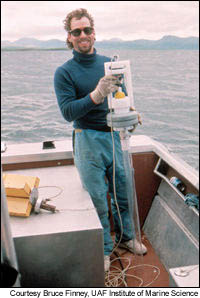forum
library
tutorial
contact

Salmon Battered by Man and Nature
by John RoachEnvironmental News Network, October 27, 2000
Listen to related RealAudio
|
the film forum library tutorial contact |

|
Salmon Battered by Man and Natureby John RoachEnvironmental News Network, October 27, 2000 Listen to related RealAudio |
 Devoured at the dinner table, blocked by
hydroelectric dams and crowded out by
urban development, sockeye salmon face a
big burden in humans. And now it turns out
that natural climate variability also wreaks
havoc on the fish, according to research in
today’s Science.
Devoured at the dinner table, blocked by
hydroelectric dams and crowded out by
urban development, sockeye salmon face a
big burden in humans. And now it turns out
that natural climate variability also wreaks
havoc on the fish, according to research in
today’s Science.
“I definitely wouldn’t want people to use climate to take humans off the hook,” said Bruce Finney, a marine scientist at the University of Alaska in Fairbanks. “But climate change is a regulator in the population cycle going up and down.”
Sockeye gain 99 percent of their body mass while at sea on a diet of plankton, squid and small fish. When the fish return to freshwater lakes to spawn and die, their carcasses release the isotope nitrogen-15.
Since few other fish or atmospheric factors add nitrogen-15 to freshwater lake ecosystems, sediment cores from five Alaskan lakes allowed the researchers to reconstruct the species’ population history over the past 300 years.
The history shows several major fluctuations in nitrogen-15 levels. These fluctuations suggest decreases in the sockeye population during the early 18th and 19th centuries, periods that tree-ring data indicates were cooler in Alaska.
 “It is not thought that the temperature change
is the direct cause,” said Finney. “It is thought
that as the climate changes the way the ocean
works, it changes availability of food for young
salmon.”
“It is not thought that the temperature change
is the direct cause,” said Finney. “It is thought
that as the climate changes the way the ocean
works, it changes availability of food for young
salmon.”
The fluctuations appear to be tied to a phenomenon known as the Pacific decadal oscillation, which warms waters along the western coast of North America during its positive stage.
The warmer waters that boost sockeye populations in Alaska appear to be devastating to populations in the Pacific Northwest, said Finney.
As profound as the impact of climate variation can be on sockeye populations, the researchers’ data also confirmed fallout from overfishing.
Sockeye carcasses act as fertilizer for lake ecosystems, providing food to juvenile sockeye during the first few years of their lives. In some instances, overfishing has robbed lakes of the nutrients needed by subsequent generations of salmon.
For example, sockeye harvests from the Karluk Lake system began to decline shortly after commercial fishing began in 1882. By the 1970s, salmon harvests that had peaked at nearly 4 million declined to just 100,000.
 “Our data suggests that the
prolonged 20th century collapse of
the Karluk sockeye fishery was
driven in part by reductions in the carcass-derived nutrients from overharvest,”
write Finney and colleagues.
“Our data suggests that the
prolonged 20th century collapse of
the Karluk sockeye fishery was
driven in part by reductions in the carcass-derived nutrients from overharvest,”
write Finney and colleagues.
The researchers hope that fisheries managers will begin to include climate change and the nutrient cycle into their calculations as they determine the maximum number of salmon that fishermen can harvest each year.
“I don’t think there is a recipe, you need to look at each system individually,” said Finney. “I think we need to be as conservative as possible, to do everything possible to reduce stresses on fish.”
Related Link: RealAudio
learn more on topics covered in the film
see the video
read the script
learn the songs
discussion forum
